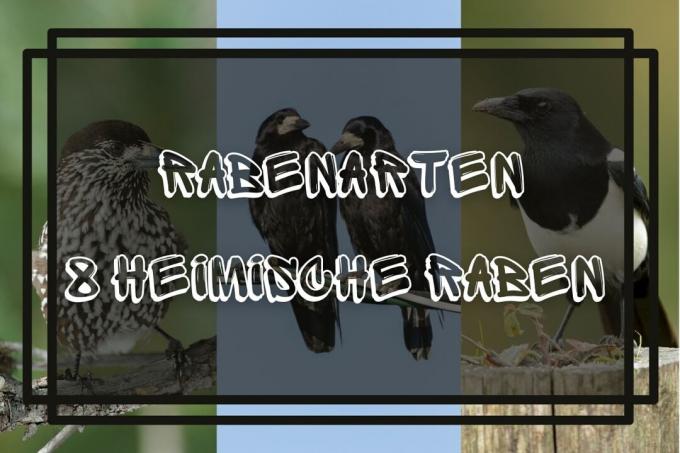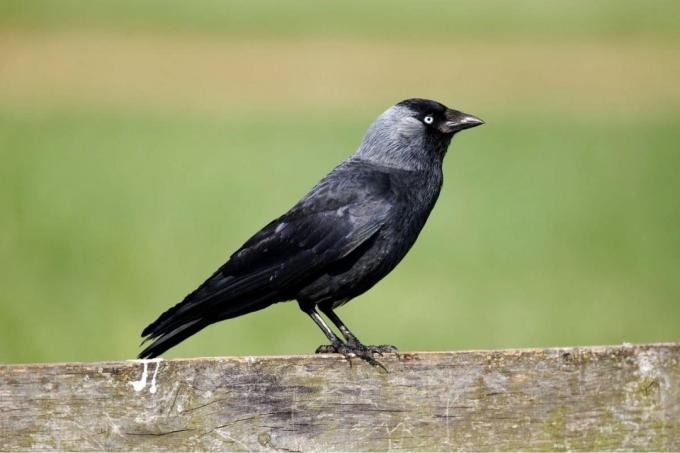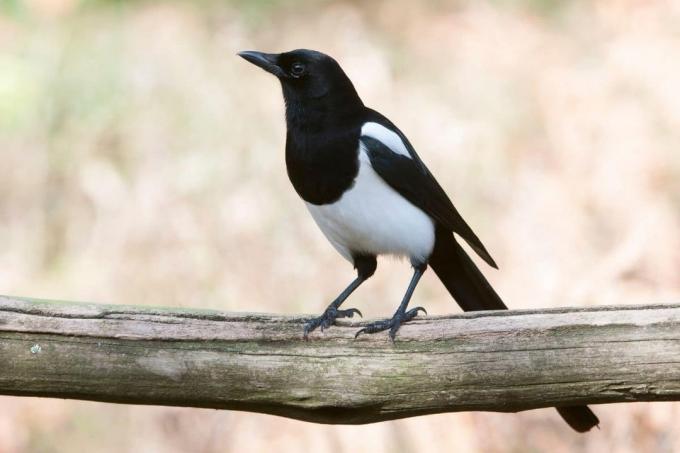
table of contents
- 8 native raven species
- Carrion crow (Corvus corone)
- Alpine chough (Pyrrhocorax graculus)
- Jackdaw (Corvus monedula)
- Eurasian Jay (Garrulus glandarius)
- Magpie (pica pica)
- Common raven (Corvus corax)
- Blue jay (Nucifraga caryocatactes)
- Rook (Corvus frugilegus)
- frequently asked Questions
Corvidae are characteristic inhabitants of urban and rural areas. Not everyone knows which native raven species each bird is. We introduce you to the 8 domestic corvids.
In a nutshell
- 8 corvidae species are native to Germany
- differ significantly in height
- many species nest in large numbers in urban areas
- Diet is varied and often opportunistic
- Corvids are some of the most intelligent songbirds
8 native raven species
A manageable number of corvids is native to Germany. Above all, the crows and ravens are known, which differ in their characteristics mainly in their size. Ravens, like the common raven, are significantly larger than crows. The other corvids are even smaller and at first glance do not resemble the most famous Corvidae, as they do not have a characteristic dark plumage. As you can already see, the world of domestic corvids is extremely exciting. We introduce you to the 8 species that live in Germany.
Carrion crow (Corvus corone)

- Occurrence: Europe to Japan, southernmost distribution to the Mediterranean Sea and northern China, northernmost distribution to Lapland and northern Russia
- habitat: Meadows, fields, forests, villages, cities and industrial areas
- Coloring hooded crow morph: basic gray color, wings, breast, tail, wings and beak black
- Carrion morph coloration: pure black, dark eyes, black beak
- length: 45 to 47 cm
- Wingspan: 93 to 105 cm
- Weight (female): 350 to 660 g
- Weight (male): 400 to 750 g
- Mating season: March to the end of June
- Breeding site: in tall trees, rock niches, masts and buildings
- Number of eggs: 2 to 6 blue-green eggs, spotted brown-black
- Incubation period: 20 days
- Nestling time: 35 days
- Breeding frequency: 1 brood per year
- nourishment: Carrion, nuts, seeds, bird eggs, insects and other invertebrates, small mammals and waste
- Life expectancy: 15 to 19 years
- call: numerous vocalizations audible, most often a strong "krah"
- particularities: extremely intelligent
- Bird migration: Stand bird
Note: Often the hooded crow and carrion crows are referred to as two different native raven species due to their differently colored plumage. Both are morphs of the carrion crow, which can be found in different regions of Germany.
Alpine chough (Pyrrhocorax graculus)

- Occurrence: High mountains in Eurasia and North Africa, in Germany only to be found in the Alps
- habitat: alpine scree fields, alpine pastures, mountain forests and settlements
- Appearance: basic black color, head feathers shimmering bluish, legs yellow to dark red, yellow beak short and curved, long tail feathers
- length: 34 to 39 cm
- Wingspan: 74 to 84 cm
- Weight (female): 160 to 270 g
- Weight (male): 190 to 290 g
- Mating season: May to mid-July
- Breeding site: in well hidden rock niches
- Number of blackbird eggs: 4 to 5 white eggs, spotted brown
- Incubation period: 22 days
- Nestling time: 45 days
- Breeding frequency: 1 brood per year
- nourishment: Insects and other invertebrates, berries, bird eggs, carrion and seeds
- Life expectancy: 20 years
- call: light and less croaking, mostly "gritty" or "zijag"
- particularities: Flight speeds of 80 km / h, in a dive up to 200 km / h, sails in the air for long periods of time
- Bird migration: Stand bird
Jackdaw (Corvus monedula)

- Occurrence: Europe to Central Asia and North Africa, in Fennoscandinavia only in coastal areas
- habitat: Forests, parks, cultural landscapes, urban settlements and cliffs
- Appearance: completely black-gray to black in color, bluish shimmer, wing tips light gray to white, white eyes, strong beak, slightly curved, medium-long tail, slightly rounded
- length: 33 to 40 cm
- Wingspan: 67 to 72 cm
- weight: 175 to 300 g
- Mating season: April to June
- Breeding site: in rock holes, old wood, building niches and trees
- Number of blackbird eggs: 3 to 6 bluish eggs, speckled dark
- Incubation period: 18 to 20 days
- Nestling time: 45 days
- Breeding frequency: 1 brood per year
- nourishment: Insects and other invertebrates, seeds, snails, bird eggs, small mammals, carrion and waste
- Life expectancy: 13 to 20 years, in captivity up to 30 years
- call: short and clicking "kja" or "chack"
- particularities: agile flier, top speeds of up to 60 km / h
- Bird migration: Stand bird
Eurasian Jay (Garrulus glandarius)

- Occurrence: Europe via China to Southeast Asia and Japan, parts of North Africa and the Middle East
- habitat: Forests, city parks, gardens and cities
- Appearance: Plumage red-gray, throat and rump white, head feathers dark brown, black beard stripes, wings conspicuously blue-black patterned, pink legs and feet
- length: 33 to 35 cm
- Wingspan: 53 to 59 cm
- weight: about 170 g
- Mating season: April to June
- Breeding site: in tree tops or bushes
- Number of blackbird eggs: 3 to 5 light green, sand colored or light brown eggs, speckled brown
- Incubation period: 14 days
- Nestling time: 20 days
- Breeding frequency: 1 brood per year
- nourishment: Acorns and other nuts, seeds, fruits, berries, insects, bird eggs, less often small mammals
- Life expectancy: 10 to 17 years
- call: loud "dchää-dchää"
- particularities: Females are usually heavier and larger than males, can imitate calls from other bird species and all kinds of noises
- Bird migration: Partial puller in Germany
Magpie (pica pica)

- Occurrence: Europe to East Asia, parts of North Africa
- habitat: Cities, villages, parks and open cultural landscapes
- Appearance: basic black color, belly, shoulders, flanks and hand wings white, long tail feathers, strong and curved beak
- length: 46 cm
- Wingspan: 45 to 53 cm
- Weight (female): 180 to 200 g
- Weight (male): 200 to 270 g
- Mating season: March to June
- Breeding site: in trees, hedges and bushes
- Number of blackbird eggs: 4 to 8 green eggs, spotted brown
- Incubation period: 21 days
- Nestling time: 28 days
- Breeding frequency: 1 brood per year
- nourishment: Insects and other invertebrates, bird eggs, small mammals, carrion, berries, fruits and less often waste
- Life expectancy: up to 16 years
- call: characteristic chatter ("schäck-schäck-schäck"), slightly croaking
- Bird migration: Stand bird
Note: You don't have to worry about “thieving magpies”. This native species of raven does not intentionally steal jewelry or other valuables.
Common raven (Corvus corax)

- Occurrence: Europe to East Asia, parts of North Africa, North America to Mexico
- habitat: Forests, mountains, coasts, semi-open and open cultural landscapes, to be found less often in close proximity to people
- Appearance: completely black plumage with a metallic blue-violet or green sheen, black feet, strong beak, very large with a distinct ridge, short, wedge-shaped tail
- length: 55 to 70 cm
- Wingspan: 115 to 130 cm
- Weight (female): 1.07 to 1.24 kg
- Weight (male): 1.08 to 1.37 kg
- Mating season: January to April
- Breeding site: in rock niches, on tall trees, less often on buildings and electricity pylons
- Number of blackbird eggs: 3 to 6 light green eggs, spotted green-gray to green-brown
- Incubation period: 21 days
- Nestling time: 45 days
- Breeding frequency: 1 brood per year
- nourishment: Omnivorous and opportunist, preference for carrion, small vertebrates, birds, bird eggs, less often waste
- Life expectancy: 20 to 30 years, in captivity 40 years
- call: loud “kraa” or “rak, rak, rak”, extensive vocalizations for communication are available
- particularities: Type of raven with the most pleasant singing voice, occurs in numerous legends, myths and fairy tales
- Bird migration: Stand bird
Note: Along with the ore ravens (Corvus crassirostris) native to East Africa, common ravens are the largest passerine birds (Passeriformes).
Blue jay (Nucifraga caryocatactes)

- Occurrence: Europe to East Asia
- habitat: Coniferous forests with high levels of the following Conifers: Swiss stone pines (Pinus cembra), spruces (Picea) or hazelnuts (Corylus avellana), city parks and gardens are less frequent
- Appearance: basic dark brown color, dotted with white, tail and wing tips black, extremely long beak, shaped like a chisel, light gray
- length: 20 to 32 cm
- Wingspan: 50 to 60 cm
- Weight (female): 120 to 180 g
- Mating season: April to July
- Breeding site: in crowns or close to the trunk of conifers
- Number of blackbird eggs: 3 to 5 white-green eggs, speckled with light brown
- Incubation period: 14 to 21 days
- Nestling time: 25 days
- Breeding frequency: 1 brood per year
- nourishment: Conifer seeds and other seeds, hazelnuts, fruits, more rarely small vertebrates and bird eggs
- Life expectancy: 15 years
- call: hard, often and quickly repeated "krrrrääh", rarely makes noises, sometimes imitate jackdaws and magpies
- particularities: can be confused with the starling (Sturnus vulgaris), cracks nuts with their beak without any problems
- Bird migration: Stand bird
Rook (Corvus frugilegus)

- Occurrence: Europe to southern Japan, Middle East to Egypt, immigrated to New Zealand
- habitat: flat or hilly fields and meadows with forests, wood or trees, sometimes overwinter in cities
- Appearance: Completely black basic color, shiny red, medium-long tail feathers, pointed, slender beak, pointed, beak base naked and dirty-white
- length: 46 cm
- Wingspan: 98 cm
- weight: 350 and 550 g
- Mating season: March to June
- Breeding site: in woods, trees and, less often, buildings, under bridges or on the ground
- Number of blackbird eggs: 3 to 6 gray-green eggs, speckled with dark
- Incubation period: 18 to 20 days
- Nestling time: 30 to 32 days
- Breeding frequency: 1 brood per year
- nourishment: Insects and other invertebrates, small mammals, seeds and nuts, berries, fruits and carrion
- Life expectancy: 3 to 20 years
- call: high, exultant "kah", like carrion crows, have extensive vocalizations
- particularities: Flight speeds of 80 km / h, in a dive up to 200 km / h, sails in the air for long periods of time
- Bird migration: Resident bird or partial puller (maximum 1,000 km range)
frequently asked Questions
The two morphs of the carrion crow developed in different parts of Europe, which is how the plumage colors came about. The hooded crow with the gray-black morph is native to Mecklenburg-Western Pomerania, Schleswig-Holstein and along the Polish and northeastern Czech borders. The completely black carrion crow breeds in the rest of the country. Hybrids are often found along the range limits.
No, the Chough (Pyrrhocorax pyrrhocorax) has been around since the beginning of the 20th century. Century no longer at home in Germany and Austria. In the German-speaking area there are only a few breeding pairs to be found in Switzerland. Individual specimens can be seen in the German Alpine region, but they are exclusively temporary visitors and not a native species of raven.
Due to their size and intelligence, they are rarely hunted by other animals. Typical predators of the native species include birds of prey, including the goshawk (Accipiter gentilis), eagle owl (Bubo bubo) and peregrine falcon (Falco peregrinus). Raccoons (Procyon lotor) and martens (Mustelidae) are the only mammals in Germany that prey on corvids. Dangerous parasites are feather mites.



